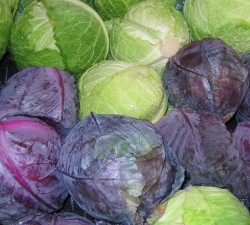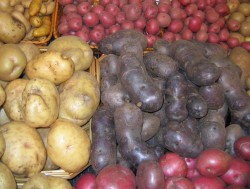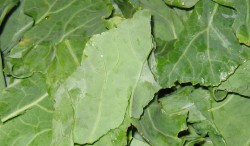All the Greens that Grow: Umami in Vegetables
Just when you thought I was finished with the umami, here comes a little bit more, this time, about umami in vegetables.
We’ve already discussed umami in tomatoes, corn, mushrooms and fermented cabbage dishes such as kimchee and saurkraut. (Actually, when I wrote about umami in the West, I forgot to mention saurkraut–another lactobacillus fermented cabbage preparation. But, here I am, mentioning it, so now you know. Like kimchee, there is umami in saurkraut. And, like kimchee, which tastes good simmered with meat in braised dishes, saurkraut braised with meat and beer or wine is a classic that teams up lots of umami ingredients to make a powerhouse of a dish–full of flavor and nummy amino acids.)
Not surprisingly, then, members of the brassica family, which includes cabbages and all sorts of happy leafy green guys that are full of folate and iron and vitamins and good stuff, are noted to have lots of potential umami locked within their tissues. However, most of the taste is not apparent until the greens are either cooked “beyond palatability” or they are fermented. The “cooking beyond palatability” comment is straight from the authors of The Fifth Taste (Kasabian and Kasabian, pp. 26); I am of the belief that it is a personal taste thing. In the South, all deep green leafies are eaten cooked to death with a hunk of pork or pork fat and plenty of water. As I noted in my kale recipe, this does cook out a lot of the vitamins, however, most every southerner I know drinks up the juice, or “pot likker” where all of the water soluable vitamins have gone, so nothing is particularly wasted. Some of the vitamins that are destroyed by heat are gone, but then, have you ever gnawed on a tough old kale leaf? Yeah, I bet you got strings in your teeth, too. Ick.
Anyway, as I was saying, the traditional way of eating greens is to cook them to death, and lo, and behold–they really taste good when they are done, and I am pretty sure it isn’t just the power of pig fat that manages it.
There is apparently a good amount of natural umami in potatoes, particularly mature ones. I can see that–particularly when you have a batch of roasted or fried ‘taters, they do seem awfully earthy and good. Browning them seems to bring out the flavor, and really–I think that leaving the skin on helps, too. There is a lot of flavor in the peel of the potato that gets lost if you toss it out, so I almost always leave them on. I just scrub my potatoes almost unto death before cooking them. One thing I have noticed, however, is how beautifully potatoes pair with either truffles or mushrooms. Okay, truffle -oil- or mushrooms–I haven’t yet cooked with a truffle yet, and if I got my hands on one, I probably would not be cooking potatoes.
Maybe risotto.
Carrots, I am told on pretty good authority, have a good bit of umami, but I suspect that the older ones have more. I would bet that parsnips, being related to carrots, probably have some, too, and that both would be enhanced by roasting or simmering with other umami rich ingredients. Like, cut up some potatoes, carrots and parsnips, and roast them in the bottom of the pan you are roasting a chicken in. A chicken which you have loosened the skin, and stuffed ground up sauteed mushrooms underneath it. That sounds pretty good, especially if you baste it all with some sherry now and again.
And add garlic–you know, because while garlic seems to lack umami, it makes up for it by tasting like garlic, which is one of my favorite flavors of all time.
As noted before, soybeans are umami powerhouses; according to the Kasabians, dried legumes of other sorts carry a kind of umami known as “synergizing umami.” This is a rather complex interaction between amino acids and nucleotides which amps up the discernable umami flavor in foods. (Not a lot of information is available yet on how that works, but apparently, some sorts of foods have nucleotides that kick up any umami in their presence up a few notches.)
Anyway, dried legumes such as kidney beans, navy beans, lima beans and lentils all are apparently well endowed with synergizing umami, which means that if you cook them with a straight up umami source such as dried mushrooms, chicken stock, red wine and maybe a little tiny bit (or a big hunk) of bacon or ham, they will taste even better, as all of the amino acids and nucleotides get together and form a happy square dance that entertains the taste buds throughout the meal.
What it all boils down to is this–if you want to cook your greens to death–go for it. If you don’t, don’t worry, but in either case, add some good umami ingredients. You have to cook dried beans to death, but they are better if you add umami ingredients, so, why not? As for potatoes–keep them in their jackets, and fry or roast them, and as for carrots and parsnips–they are good roasted, too.
What I find most interesting so far about all of this information, is that the vegetables that are being cited as being so tasty and good, are the ones that poor folks all over Europe and the US used to eat. (And they probably still do.) Nothing is cheaper than carrots, potatoes, dark leafy greens, cabbages, and dried beans.
It just makes me think that I always was right when I would say, “Peasant food is good food,” before digging into a meal of pinto beans, fried potatoes and cornbread with a bowl of collard greens on the side.
4 Comments
RSS feed for comments on this post.
Sorry, the comment form is closed at this time.
Powered by WordPress. Graphics by Zak Kramer.
Design update by Daniel Trout.
Entries and comments feeds.






As the proud owner of a Grandma from Kentucky, I have to say Best. Post.
Ever. 😀 I ought to print it out and show it to her. “Hey Grandma, some
food researchers told me why your food is so good!” Hee.
“A chicken which you have loosened the skin, and stuffed ground up sauteed
mushrooms underneath it.”
I think my head just exploded from the delicious. My good god. Wow. Now
the roasting root veg under the chicken, I knew that, but…mushrooms under
the skin. Wow.
I might have missed it in a previous post…how about broccoli, then? Seems
like it would have lots of umami. I ask because I just roasted some, and
it’s fabulous.
Comment by Barbara — January 10, 2006 #
Actually, that above comment is from Jennifer, who was having trouble getting it posted, so she emailed it to me. And I posted it and it still came up under my name.
But, in answer to her question–broccoli and cauliflower are both brassicas–in the same family as the leafy greens and cabbages, so my suspicion is that they, too, are endowed with natural umami.
As for the minced up mushrooms under the skin–that is a French trick–a mixture of minced up, sauteed mushrooms is called duxelle, and they are commonly used as stuffings or forcemeat (farsi) in meat cookery, terrine, pate and the like. I can’t take credit for the idea at all, just so you know.
Most duxelle, however, are made from fresh mushrooms. I think that a combination of fresh and dried mushrooms that had been rehydrated in red wine or sherry would be the best. The juices and wine from the mushrooms would bathe the flesh of the chicken, and enrich the pan drippings, which are already making the vegetables underneath them a thing of beauty.
As for your Kentucky grandma–both of my grandmas were from West Virginia, and I bet they cooked a damned site like yours still does. Feel free to let her know that science has proven how her food is so good.
All of this umami business has started really showing me that all the old ways of the kitchen–the way that grandmothers around the globe in fine homes and sometimes, especially, in poor ones–the frugal ways were really on the right track, and it would be a shame to lose all of that in the name of fast food.
Not only is peasant food good food, but slow food is good food, too.
Comment by Barbara — January 10, 2006 #
So what you’re saying is that my dinner tonight of good ol’ vegetable soup was full of umami? Sweet!
🙂
Cabbage, potatoes, carrots, mushrooms, plus lots of other stuff, topped off with a good shaving of parmiggiano reggiano (yes, I know I butchered the spelling of that). I think I’ll toss in some soybeans (given that I’d not gotten around to putting in the beans yet) for tomorrow and have me an umami feast!
This post was really just me dropping in to say how very much I enjoy your posts…
Comment by Lizzymommy — January 11, 2006 #
Thank you, Lizzymommy–I am glad that you are enjoying the blog!
Try putting kale in soup sometime–it adds a lot of flavor and it is how I slip kale past Zak on a semi-regular basis!
Comment by Barbara — January 11, 2006 #